
Alessandro di Mariano di Vanni Filipepi, known as Sandro Botticelli, was an Italian painter of the Early Renaissance. Botticelli's posthumous reputation suffered until the late 19th century, when he was rediscovered by the Pre-Raphaelites who stimulated a reappraisal of his work. Since then, his paintings have been seen to represent the linear grace of late Italian Gothic and some Early Renaissance painting, even though they date from the latter half of the Italian Renaissance period.
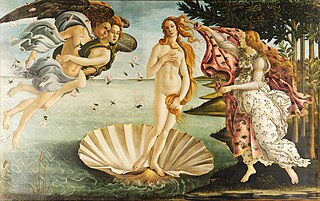
The Birth of Venus is a painting by the Italian artist Sandro Botticelli, probably executed in the mid 1480s. It depicts the goddess Venus arriving at the shore after her birth, when she had emerged from the sea fully-grown. The painting is in the Uffizi Gallery in Florence, Italy.

Pallas and the Centaur is a painting by the Italian Renaissance painter Sandro Botticelli, c. 1482. It is now in the Uffizi Gallery in Florence. It has been proposed as a companion piece to his Primavera, though it is a different shape. The medium used is tempera paints on canvas and its size is 207 x 148 cm. The painting has been retouched in many places, and these retouchings have faded.

Simonetta Vespucci, nicknamed la bella Simonetta, was an Italian noblewoman from Genoa, the wife of Marco Vespucci of Florence and the cousin-in-law of Amerigo Vespucci. She was known as the greatest beauty of her age in Italy, and was allegedly the model for many paintings by Sandro Botticelli, Piero di Cosimo, and other Florentine painters. Some art historians have taken issue with these attributions, which the Victorian critic John Ruskin has been blamed for promulgating.

Saint Augustine in His Study is a fresco painting of Augustine of Hippo executed in 1480 by the Italian Renaissance master Sandro Botticelli. It is in the church of Ognissanti in Florence.

The Portrait of Smeralda Brandini is a tempera on panel painting by the Italian Renaissance artist Sandro Botticelli of about 1475, in the Victoria and Albert Museum, London.

The Adoration of the Magi is a painting by the Italian Renaissance painter Filippino Lippi. It is signed and dated at 1496. It is housed in the Uffizi of Florence.
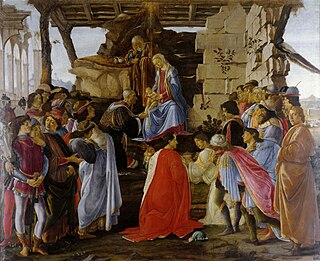
The Adoration of the Magi is a painting by the Italian Renaissance master Sandro Botticelli. Botticelli painted this piece for the altar in Gaspare di Zanobi del Lama's chapel in Santa Maria Novella around 1475. This painting depicts the Biblical story of the Three Magi following a star to find the newborn Jesus. The image of the altarpiece centers on the Virgin Mary and the newborn Jesus, with Saint Joseph behind them. Before them are the three kings who are described in the New Testament story of the Adoration of the Magi. The three kings worship the Christ Child and present him with gifts of gold, frankincense and myrrh. In addition, the Holy Family is surrounded by a group of people who came to see the child who was said to be the son of God.

The Last Communion of Saint Jerome is a painting by the Italian Renaissance master Sandro Botticelli, finished around 1494–1495. It is now in the Metropolitan Museum of Art, in New York City.
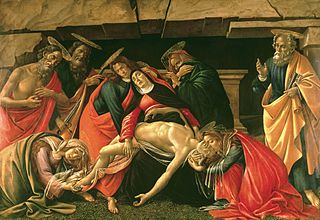
The Lamentation over the Dead Christ, is a painting of the common subject of the Lamentation of Christ by the Italian Renaissance master Sandro Botticelli, finished around 1490–1492. It is now in the Alte Pinakothek, in Munich.
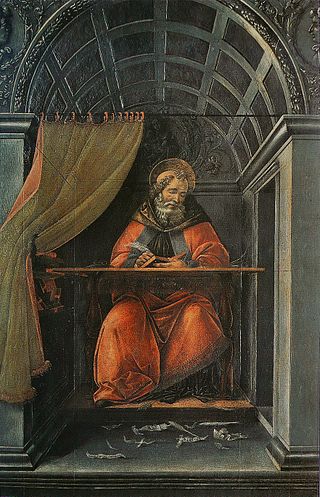
Saint Augustine in His Study, is a painting by the Italian Renaissance master Sandro Botticelli, finished around 1490–1494. It is housed in the Uffizi, in Florence.

The Holy Trinity or Pala delle Convertite is an altarpiece by the Italian Renaissance painter Sandro Botticelli, dating to c. 1491–1493. It is housed at Courtauld Institute of Art in London.
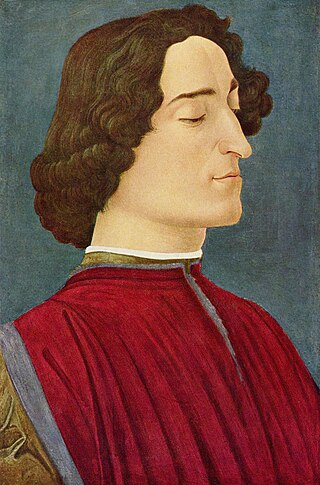
The Portrait of Giuliano de' Medici is a painting of Giuliano de' Medici (1453-1478) by the Italian Renaissance painter Sandro Botticelli, probably painted soon before Giuliano was assassinated in the Pazzi Conspiracy in 1478. It belongs to the Berlin State Museums, and is in the Gemäldegalerie, Berlin.

Portrait of a Young Woman is a painting which is commonly believed to be by the Italian Renaissance painter Sandro Botticelli, executed between 1480 and 1485. Others attribute authorship to Jacopo da Sellaio. The woman is shown in profile but with her bust turned in three-quarter view to reveal a cameo medallion she is wearing around her neck. The medallion is a copy in reverse of "Nero's Seal", a famous antique carnelian representing Apollo and Marsyas, which belonged to Lorenzo de' Medici.

Portrait of a Man with a Medal of Cosimo the Elder, also known as Portrait of a Youth with a Medal, is a tempera painting by Italian Renaissance painter Sandro Botticelli. The painting features a young man displaying in triangled hands a medal stamped with the likeness of Cosimo de' Medici. The identity of the young man has been a long-enduring mystery. Completed in approximately 1475, it is on display in the Uffizi Gallery of Florence.

Primavera, is a large panel painting in tempera paint by the Italian Renaissance painter Sandro Botticelli made in the late 1470s or early 1480s. It has been described as "one of the most written about, and most controversial paintings in the world", and also "one of the most popular paintings in Western art".

A Young Man Being Introduced to the Seven Liberal Arts, also known as Lorenzo Tornabuoni Presented by Grammar to Prudentia and the other Liberal Arts or Lorenzo Tornabuoni Being Introduced to the Liberal Arts, is a painting by the Italian Renaissance painter Sandro Botticelli, circa 1483–1486. The painting and its companion piece, Venus and the Three Graces Presenting Gifts to a Young Woman, originally decorated Villa Lemmi, a country villa near Florence owned by Giovanni Tornabuoni, uncle of Lorenzo de' Medici and head of the Roman branch of the Medici Bank. They were probably commissioned for the 1486 wedding of Giovanni's son Lorenzo to Giovanna of the Albizzi family, and are therefore thought to depict the two.

Venus and the Three Graces Presenting Gifts to a Young Woman, also known as Giovanna degli Albizzi Receiving a Gift of Flowers from Venus, is a fresco painting by the Italian Renaissance painter Sandro Botticelli of circa 1483–1486. The painting and its companion piece, A Young Man Being Introduced to the Seven Liberal Arts, originally decorated the walls of Villa Lemmi, a country villa near Florence owned by Giovanni Tornabuoni, uncle of Lorenzo de' Medici and head of the Roman branch of the Medici Bank. They were probably commissioned for the wedding in 1486 of Giovanni's son Lorenzo to Giovanna of the Albizzi family, and are therefore thought to depict the two.

Madonna with Child is a tempera painting by Italian Renaissance painter Sandro Botticelli, dating to c. 1467 and housed in the Musée du Petit Palais of Avignon, France.
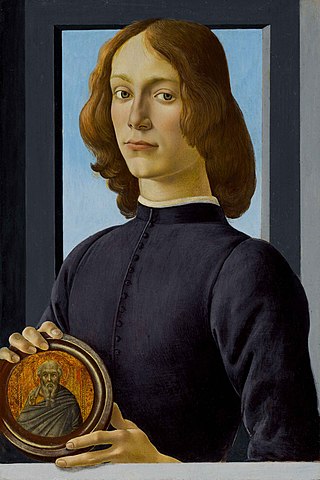
The Portrait of a Young Man Holding a Roundel is a painting attributed to Sandro Botticelli. Due to its style it has been estimated to have been painted around 1480. The identity of the portrait's subject is unknown, but analysts suggest it could be someone from the Medici family, as Lorenzo de' Medici was one of Botticelli's main benefactors.





















